SOC10236 - Applied Ethics and Sustainability: In-Depth Global Analysis
VerifiedAdded on 2023/06/11
|10
|2800
|187
Essay
AI Summary
This essay addresses the critical issue of energy usage and conservation as a major global sustainability challenge. It explores the environmental impacts of non-renewable energy sources, including emissions, waste, and land/water usage, highlighting examples like fracking-induced earthquakes and oil spills. Social elements, such as the lack of access to renewable energy in underdeveloped countries and the impact on women, are discussed. The essay also delves into the economic aspects, noting the high costs and fluctuating prices of non-renewable energy. It identifies two major ethical problems: the use of nuclear energy and the ethical concerns surrounding wind energy generation, drawing on relevant ethical theories to analyze their impacts. The business threats and opportunities associated with energy usage are examined, including the risks in oil markets and the impact of windmills on tourism. Finally, the essay proposes ethical and sustainable solutions, such as improved waste management for nuclear energy and employee training to minimize risks, as well as addressing the noise pollution from windmills.
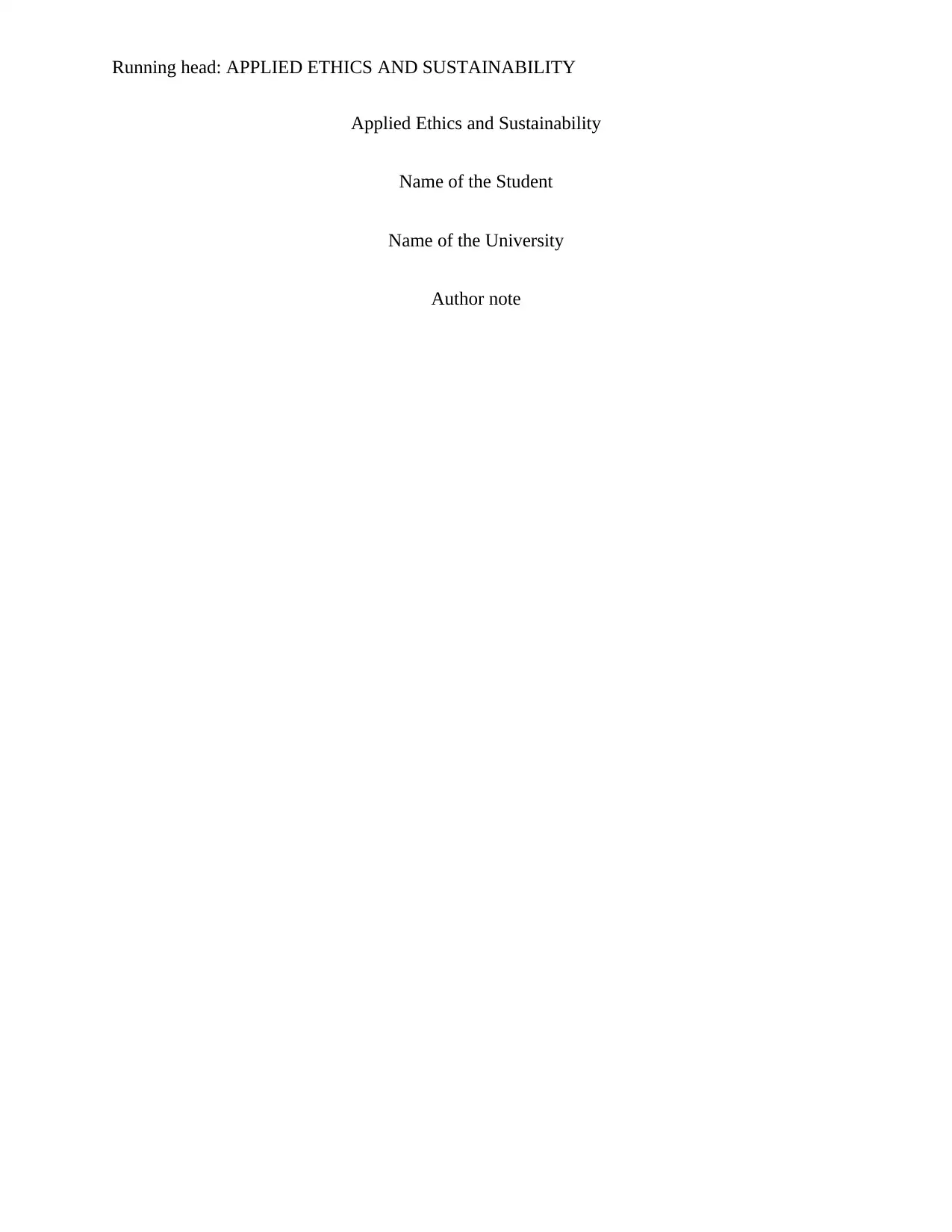
Running head: APPLIED ETHICS AND SUSTAINABILITY
Applied Ethics and Sustainability
Name of the Student
Name of the University
Author note
Applied Ethics and Sustainability
Name of the Student
Name of the University
Author note
Paraphrase This Document
Need a fresh take? Get an instant paraphrase of this document with our AI Paraphraser
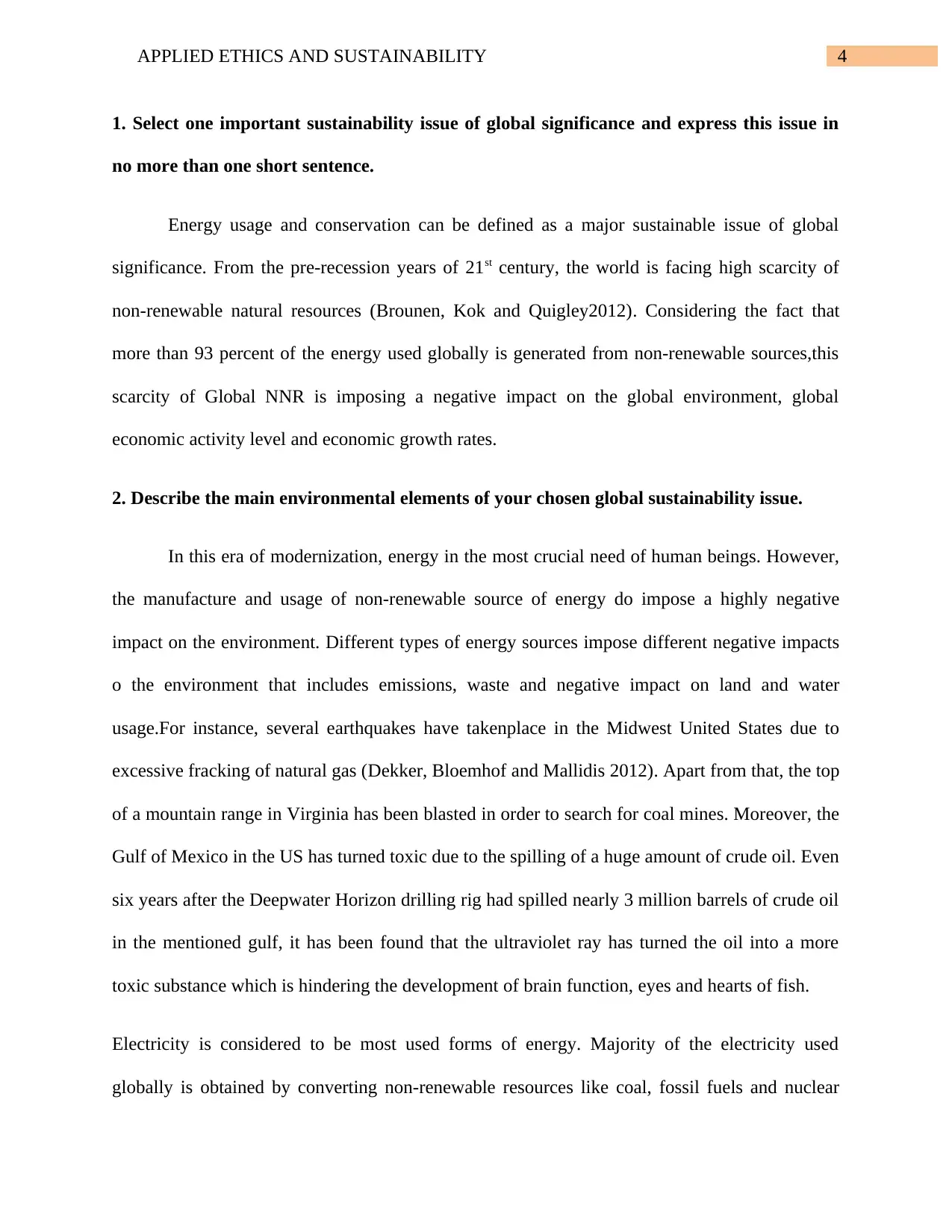
4APPLIED ETHICS AND SUSTAINABILITY
1. Select one important sustainability issue of global significance and express this issue in
no more than one short sentence.
Energy usage and conservation can be defined as a major sustainable issue of global
significance. From the pre-recession years of 21st century, the world is facing high scarcity of
non-renewable natural resources (Brounen, Kok and Quigley2012). Considering the fact that
more than 93 percent of the energy used globally is generated from non-renewable sources,this
scarcity of Global NNR is imposing a negative impact on the global environment, global
economic activity level and economic growth rates.
2. Describe the main environmental elements of your chosen global sustainability issue.
In this era of modernization, energy in the most crucial need of human beings. However,
the manufacture and usage of non-renewable source of energy do impose a highly negative
impact on the environment. Different types of energy sources impose different negative impacts
o the environment that includes emissions, waste and negative impact on land and water
usage.For instance, several earthquakes have takenplace in the Midwest United States due to
excessive fracking of natural gas (Dekker, Bloemhof and Mallidis 2012). Apart from that, the top
of a mountain range in Virginia has been blasted in order to search for coal mines. Moreover, the
Gulf of Mexico in the US has turned toxic due to the spilling of a huge amount of crude oil. Even
six years after the Deepwater Horizon drilling rig had spilled nearly 3 million barrels of crude oil
in the mentioned gulf, it has been found that the ultraviolet ray has turned the oil into a more
toxic substance which is hindering the development of brain function, eyes and hearts of fish.
Electricity is considered to be most used forms of energy. Majority of the electricity used
globally is obtained by converting non-renewable resources like coal, fossil fuels and nuclear
1. Select one important sustainability issue of global significance and express this issue in
no more than one short sentence.
Energy usage and conservation can be defined as a major sustainable issue of global
significance. From the pre-recession years of 21st century, the world is facing high scarcity of
non-renewable natural resources (Brounen, Kok and Quigley2012). Considering the fact that
more than 93 percent of the energy used globally is generated from non-renewable sources,this
scarcity of Global NNR is imposing a negative impact on the global environment, global
economic activity level and economic growth rates.
2. Describe the main environmental elements of your chosen global sustainability issue.
In this era of modernization, energy in the most crucial need of human beings. However,
the manufacture and usage of non-renewable source of energy do impose a highly negative
impact on the environment. Different types of energy sources impose different negative impacts
o the environment that includes emissions, waste and negative impact on land and water
usage.For instance, several earthquakes have takenplace in the Midwest United States due to
excessive fracking of natural gas (Dekker, Bloemhof and Mallidis 2012). Apart from that, the top
of a mountain range in Virginia has been blasted in order to search for coal mines. Moreover, the
Gulf of Mexico in the US has turned toxic due to the spilling of a huge amount of crude oil. Even
six years after the Deepwater Horizon drilling rig had spilled nearly 3 million barrels of crude oil
in the mentioned gulf, it has been found that the ultraviolet ray has turned the oil into a more
toxic substance which is hindering the development of brain function, eyes and hearts of fish.
Electricity is considered to be most used forms of energy. Majority of the electricity used
globally is obtained by converting non-renewable resources like coal, fossil fuels and nuclear
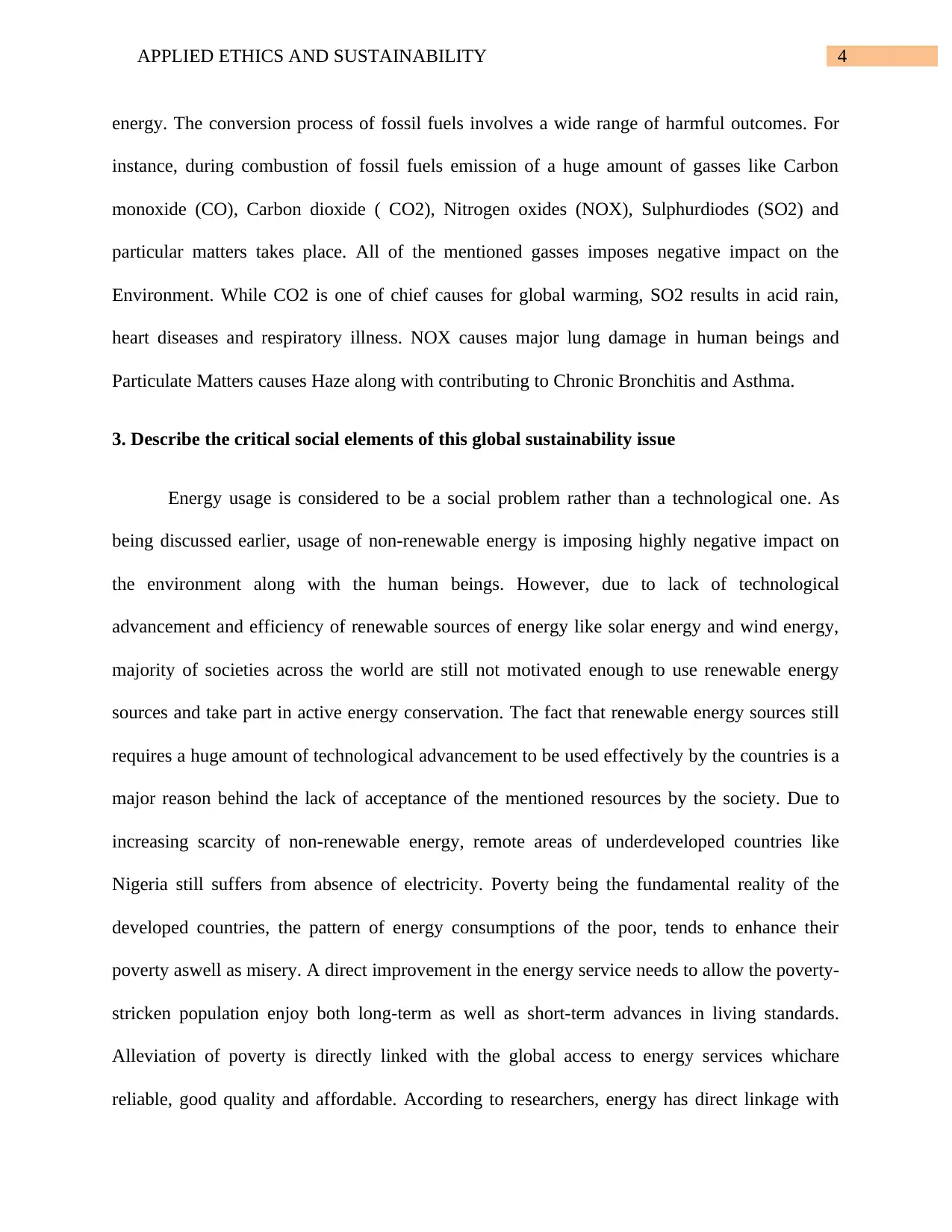
4APPLIED ETHICS AND SUSTAINABILITY
energy. The conversion process of fossil fuels involves a wide range of harmful outcomes. For
instance, during combustion of fossil fuels emission of a huge amount of gasses like Carbon
monoxide (CO), Carbon dioxide ( CO2), Nitrogen oxides (NOX), Sulphurdiodes (SO2) and
particular matters takes place. All of the mentioned gasses imposes negative impact on the
Environment. While CO2 is one of chief causes for global warming, SO2 results in acid rain,
heart diseases and respiratory illness. NOX causes major lung damage in human beings and
Particulate Matters causes Haze along with contributing to Chronic Bronchitis and Asthma.
3. Describe the critical social elements of this global sustainability issue
Energy usage is considered to be a social problem rather than a technological one. As
being discussed earlier, usage of non-renewable energy is imposing highly negative impact on
the environment along with the human beings. However, due to lack of technological
advancement and efficiency of renewable sources of energy like solar energy and wind energy,
majority of societies across the world are still not motivated enough to use renewable energy
sources and take part in active energy conservation. The fact that renewable energy sources still
requires a huge amount of technological advancement to be used effectively by the countries is a
major reason behind the lack of acceptance of the mentioned resources by the society. Due to
increasing scarcity of non-renewable energy, remote areas of underdeveloped countries like
Nigeria still suffers from absence of electricity. Poverty being the fundamental reality of the
developed countries, the pattern of energy consumptions of the poor, tends to enhance their
poverty aswell as misery. A direct improvement in the energy service needs to allow the poverty-
stricken population enjoy both long-term as well as short-term advances in living standards.
Alleviation of poverty is directly linked with the global access to energy services whichare
reliable, good quality and affordable. According to researchers, energy has direct linkage with
energy. The conversion process of fossil fuels involves a wide range of harmful outcomes. For
instance, during combustion of fossil fuels emission of a huge amount of gasses like Carbon
monoxide (CO), Carbon dioxide ( CO2), Nitrogen oxides (NOX), Sulphurdiodes (SO2) and
particular matters takes place. All of the mentioned gasses imposes negative impact on the
Environment. While CO2 is one of chief causes for global warming, SO2 results in acid rain,
heart diseases and respiratory illness. NOX causes major lung damage in human beings and
Particulate Matters causes Haze along with contributing to Chronic Bronchitis and Asthma.
3. Describe the critical social elements of this global sustainability issue
Energy usage is considered to be a social problem rather than a technological one. As
being discussed earlier, usage of non-renewable energy is imposing highly negative impact on
the environment along with the human beings. However, due to lack of technological
advancement and efficiency of renewable sources of energy like solar energy and wind energy,
majority of societies across the world are still not motivated enough to use renewable energy
sources and take part in active energy conservation. The fact that renewable energy sources still
requires a huge amount of technological advancement to be used effectively by the countries is a
major reason behind the lack of acceptance of the mentioned resources by the society. Due to
increasing scarcity of non-renewable energy, remote areas of underdeveloped countries like
Nigeria still suffers from absence of electricity. Poverty being the fundamental reality of the
developed countries, the pattern of energy consumptions of the poor, tends to enhance their
poverty aswell as misery. A direct improvement in the energy service needs to allow the poverty-
stricken population enjoy both long-term as well as short-term advances in living standards.
Alleviation of poverty is directly linked with the global access to energy services whichare
reliable, good quality and affordable. According to researchers, energy has direct linkage with
⊘ This is a preview!⊘
Do you want full access?
Subscribe today to unlock all pages.

Trusted by 1+ million students worldwide
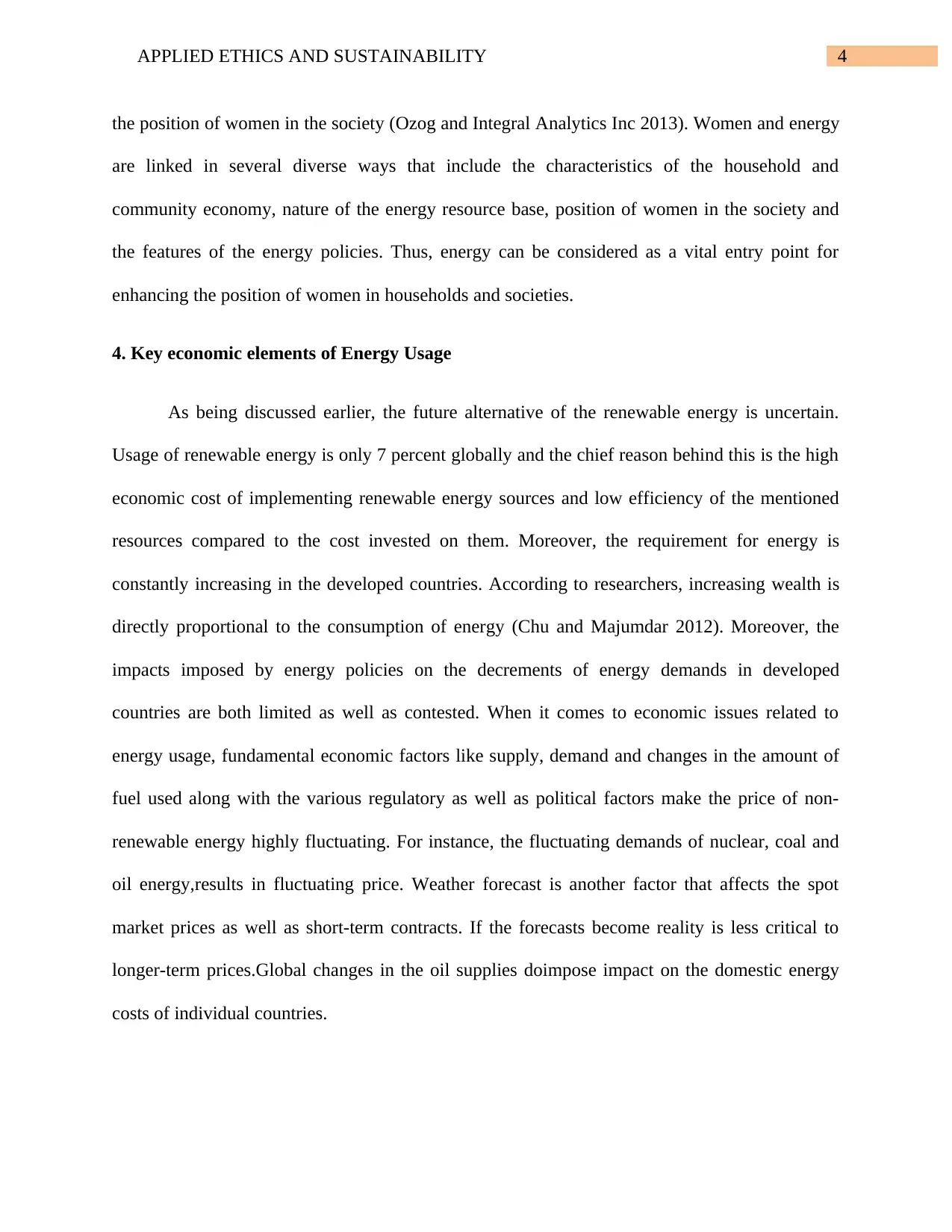
4APPLIED ETHICS AND SUSTAINABILITY
the position of women in the society (Ozog and Integral Analytics Inc 2013). Women and energy
are linked in several diverse ways that include the characteristics of the household and
community economy, nature of the energy resource base, position of women in the society and
the features of the energy policies. Thus, energy can be considered as a vital entry point for
enhancing the position of women in households and societies.
4. Key economic elements of Energy Usage
As being discussed earlier, the future alternative of the renewable energy is uncertain.
Usage of renewable energy is only 7 percent globally and the chief reason behind this is the high
economic cost of implementing renewable energy sources and low efficiency of the mentioned
resources compared to the cost invested on them. Moreover, the requirement for energy is
constantly increasing in the developed countries. According to researchers, increasing wealth is
directly proportional to the consumption of energy (Chu and Majumdar 2012). Moreover, the
impacts imposed by energy policies on the decrements of energy demands in developed
countries are both limited as well as contested. When it comes to economic issues related to
energy usage, fundamental economic factors like supply, demand and changes in the amount of
fuel used along with the various regulatory as well as political factors make the price of non-
renewable energy highly fluctuating. For instance, the fluctuating demands of nuclear, coal and
oil energy,results in fluctuating price. Weather forecast is another factor that affects the spot
market prices as well as short-term contracts. If the forecasts become reality is less critical to
longer-term prices.Global changes in the oil supplies doimpose impact on the domestic energy
costs of individual countries.
the position of women in the society (Ozog and Integral Analytics Inc 2013). Women and energy
are linked in several diverse ways that include the characteristics of the household and
community economy, nature of the energy resource base, position of women in the society and
the features of the energy policies. Thus, energy can be considered as a vital entry point for
enhancing the position of women in households and societies.
4. Key economic elements of Energy Usage
As being discussed earlier, the future alternative of the renewable energy is uncertain.
Usage of renewable energy is only 7 percent globally and the chief reason behind this is the high
economic cost of implementing renewable energy sources and low efficiency of the mentioned
resources compared to the cost invested on them. Moreover, the requirement for energy is
constantly increasing in the developed countries. According to researchers, increasing wealth is
directly proportional to the consumption of energy (Chu and Majumdar 2012). Moreover, the
impacts imposed by energy policies on the decrements of energy demands in developed
countries are both limited as well as contested. When it comes to economic issues related to
energy usage, fundamental economic factors like supply, demand and changes in the amount of
fuel used along with the various regulatory as well as political factors make the price of non-
renewable energy highly fluctuating. For instance, the fluctuating demands of nuclear, coal and
oil energy,results in fluctuating price. Weather forecast is another factor that affects the spot
market prices as well as short-term contracts. If the forecasts become reality is less critical to
longer-term prices.Global changes in the oil supplies doimpose impact on the domestic energy
costs of individual countries.
Paraphrase This Document
Need a fresh take? Get an instant paraphrase of this document with our AI Paraphraser
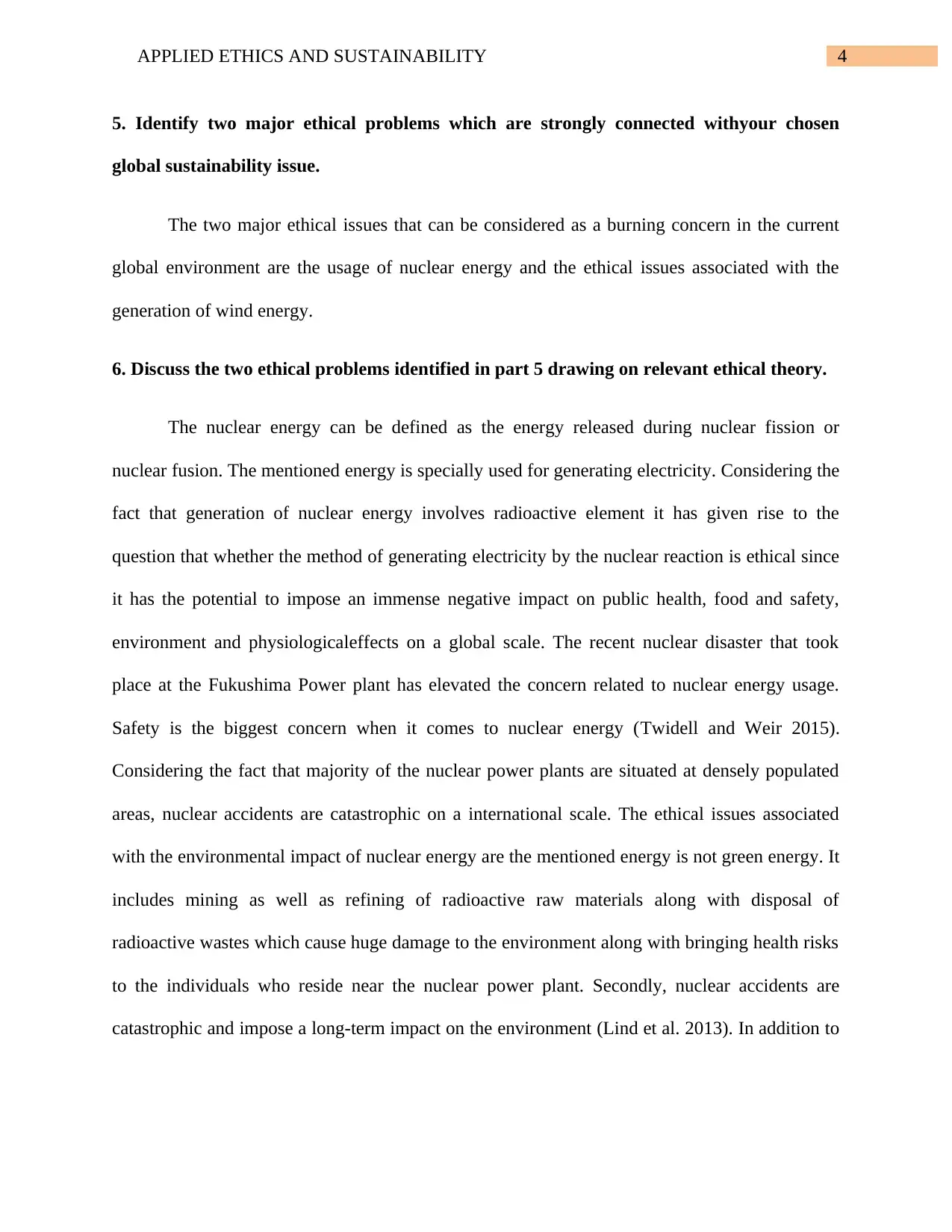
4APPLIED ETHICS AND SUSTAINABILITY
5. Identify two major ethical problems which are strongly connected withyour chosen
global sustainability issue.
The two major ethical issues that can be considered as a burning concern in the current
global environment are the usage of nuclear energy and the ethical issues associated with the
generation of wind energy.
6. Discuss the two ethical problems identified in part 5 drawing on relevant ethical theory.
The nuclear energy can be defined as the energy released during nuclear fission or
nuclear fusion. The mentioned energy is specially used for generating electricity. Considering the
fact that generation of nuclear energy involves radioactive element it has given rise to the
question that whether the method of generating electricity by the nuclear reaction is ethical since
it has the potential to impose an immense negative impact on public health, food and safety,
environment and physiologicaleffects on a global scale. The recent nuclear disaster that took
place at the Fukushima Power plant has elevated the concern related to nuclear energy usage.
Safety is the biggest concern when it comes to nuclear energy (Twidell and Weir 2015).
Considering the fact that majority of the nuclear power plants are situated at densely populated
areas, nuclear accidents are catastrophic on a international scale. The ethical issues associated
with the environmental impact of nuclear energy are the mentioned energy is not green energy. It
includes mining as well as refining of radioactive raw materials along with disposal of
radioactive wastes which cause huge damage to the environment along with bringing health risks
to the individuals who reside near the nuclear power plant. Secondly, nuclear accidents are
catastrophic and impose a long-term impact on the environment (Lind et al. 2013). In addition to
5. Identify two major ethical problems which are strongly connected withyour chosen
global sustainability issue.
The two major ethical issues that can be considered as a burning concern in the current
global environment are the usage of nuclear energy and the ethical issues associated with the
generation of wind energy.
6. Discuss the two ethical problems identified in part 5 drawing on relevant ethical theory.
The nuclear energy can be defined as the energy released during nuclear fission or
nuclear fusion. The mentioned energy is specially used for generating electricity. Considering the
fact that generation of nuclear energy involves radioactive element it has given rise to the
question that whether the method of generating electricity by the nuclear reaction is ethical since
it has the potential to impose an immense negative impact on public health, food and safety,
environment and physiologicaleffects on a global scale. The recent nuclear disaster that took
place at the Fukushima Power plant has elevated the concern related to nuclear energy usage.
Safety is the biggest concern when it comes to nuclear energy (Twidell and Weir 2015).
Considering the fact that majority of the nuclear power plants are situated at densely populated
areas, nuclear accidents are catastrophic on a international scale. The ethical issues associated
with the environmental impact of nuclear energy are the mentioned energy is not green energy. It
includes mining as well as refining of radioactive raw materials along with disposal of
radioactive wastes which cause huge damage to the environment along with bringing health risks
to the individuals who reside near the nuclear power plant. Secondly, nuclear accidents are
catastrophic and impose a long-term impact on the environment (Lind et al. 2013). In addition to
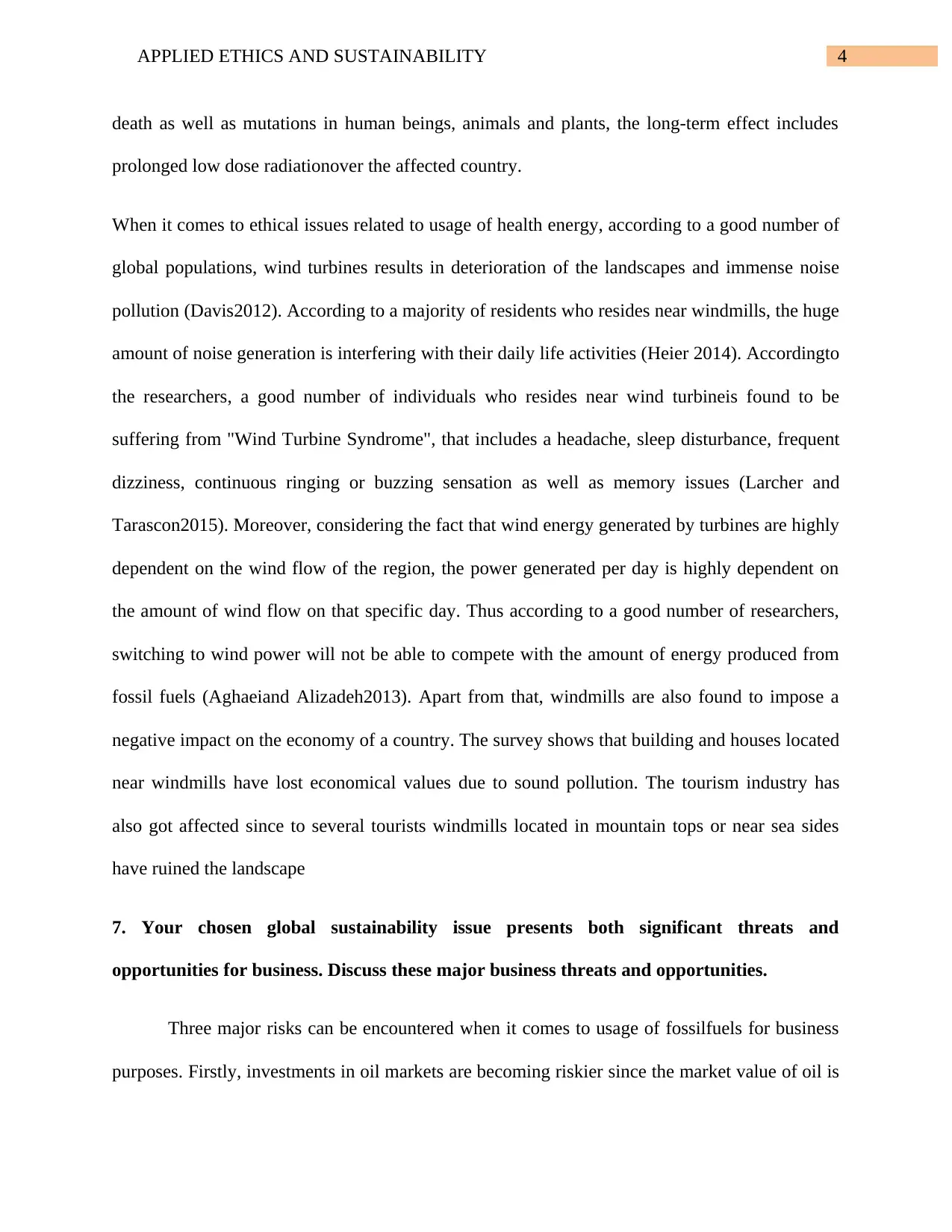
4APPLIED ETHICS AND SUSTAINABILITY
death as well as mutations in human beings, animals and plants, the long-term effect includes
prolonged low dose radiationover the affected country.
When it comes to ethical issues related to usage of health energy, according to a good number of
global populations, wind turbines results in deterioration of the landscapes and immense noise
pollution (Davis2012). According to a majority of residents who resides near windmills, the huge
amount of noise generation is interfering with their daily life activities (Heier 2014). Accordingto
the researchers, a good number of individuals who resides near wind turbineis found to be
suffering from "Wind Turbine Syndrome", that includes a headache, sleep disturbance, frequent
dizziness, continuous ringing or buzzing sensation as well as memory issues (Larcher and
Tarascon2015). Moreover, considering the fact that wind energy generated by turbines are highly
dependent on the wind flow of the region, the power generated per day is highly dependent on
the amount of wind flow on that specific day. Thus according to a good number of researchers,
switching to wind power will not be able to compete with the amount of energy produced from
fossil fuels (Aghaeiand Alizadeh2013). Apart from that, windmills are also found to impose a
negative impact on the economy of a country. The survey shows that building and houses located
near windmills have lost economical values due to sound pollution. The tourism industry has
also got affected since to several tourists windmills located in mountain tops or near sea sides
have ruined the landscape
7. Your chosen global sustainability issue presents both significant threats and
opportunities for business. Discuss these major business threats and opportunities.
Three major risks can be encountered when it comes to usage of fossilfuels for business
purposes. Firstly, investments in oil markets are becoming riskier since the market value of oil is
death as well as mutations in human beings, animals and plants, the long-term effect includes
prolonged low dose radiationover the affected country.
When it comes to ethical issues related to usage of health energy, according to a good number of
global populations, wind turbines results in deterioration of the landscapes and immense noise
pollution (Davis2012). According to a majority of residents who resides near windmills, the huge
amount of noise generation is interfering with their daily life activities (Heier 2014). Accordingto
the researchers, a good number of individuals who resides near wind turbineis found to be
suffering from "Wind Turbine Syndrome", that includes a headache, sleep disturbance, frequent
dizziness, continuous ringing or buzzing sensation as well as memory issues (Larcher and
Tarascon2015). Moreover, considering the fact that wind energy generated by turbines are highly
dependent on the wind flow of the region, the power generated per day is highly dependent on
the amount of wind flow on that specific day. Thus according to a good number of researchers,
switching to wind power will not be able to compete with the amount of energy produced from
fossil fuels (Aghaeiand Alizadeh2013). Apart from that, windmills are also found to impose a
negative impact on the economy of a country. The survey shows that building and houses located
near windmills have lost economical values due to sound pollution. The tourism industry has
also got affected since to several tourists windmills located in mountain tops or near sea sides
have ruined the landscape
7. Your chosen global sustainability issue presents both significant threats and
opportunities for business. Discuss these major business threats and opportunities.
Three major risks can be encountered when it comes to usage of fossilfuels for business
purposes. Firstly, investments in oil markets are becoming riskier since the market value of oil is
⊘ This is a preview!⊘
Do you want full access?
Subscribe today to unlock all pages.

Trusted by 1+ million students worldwide
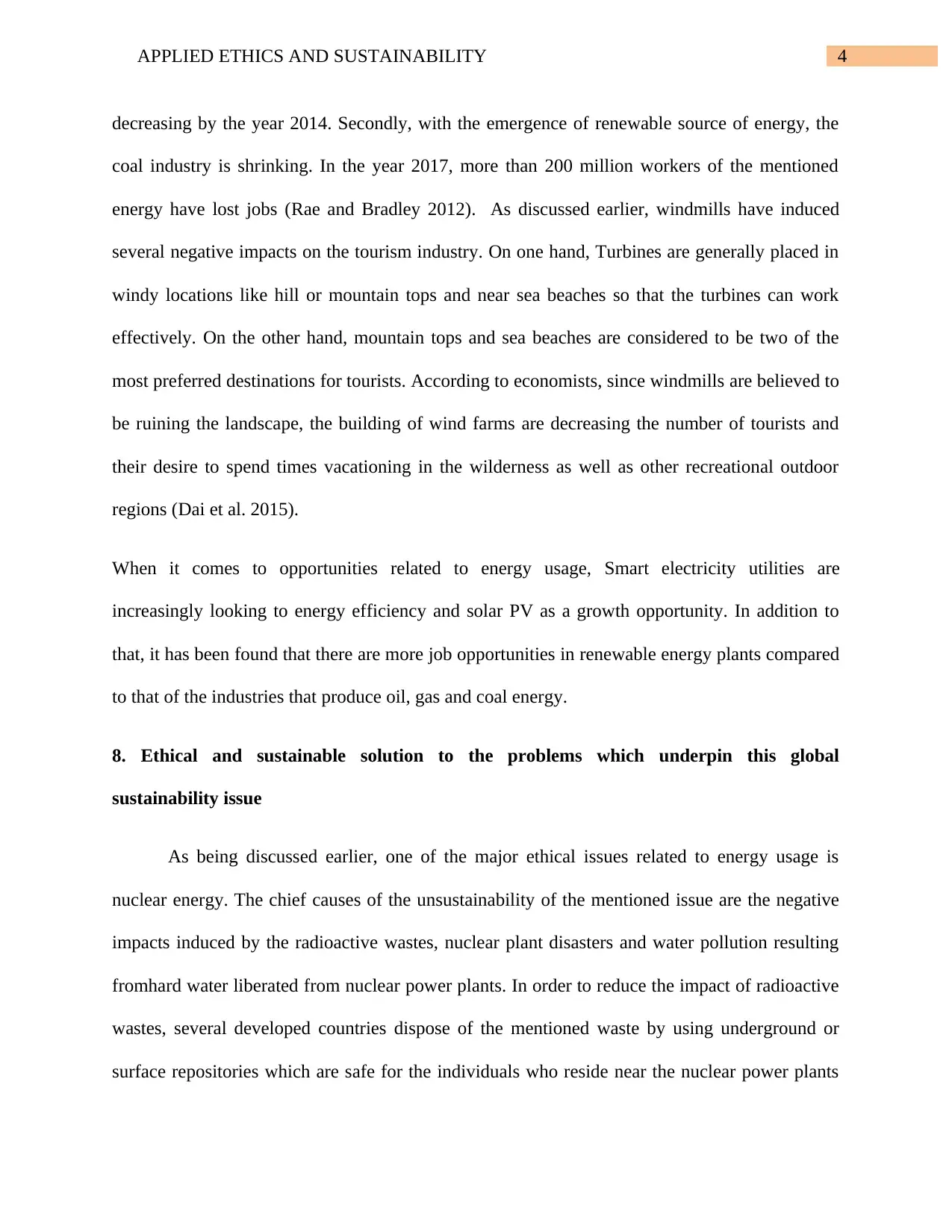
4APPLIED ETHICS AND SUSTAINABILITY
decreasing by the year 2014. Secondly, with the emergence of renewable source of energy, the
coal industry is shrinking. In the year 2017, more than 200 million workers of the mentioned
energy have lost jobs (Rae and Bradley 2012). As discussed earlier, windmills have induced
several negative impacts on the tourism industry. On one hand, Turbines are generally placed in
windy locations like hill or mountain tops and near sea beaches so that the turbines can work
effectively. On the other hand, mountain tops and sea beaches are considered to be two of the
most preferred destinations for tourists. According to economists, since windmills are believed to
be ruining the landscape, the building of wind farms are decreasing the number of tourists and
their desire to spend times vacationing in the wilderness as well as other recreational outdoor
regions (Dai et al. 2015).
When it comes to opportunities related to energy usage, Smart electricity utilities are
increasingly looking to energy efficiency and solar PV as a growth opportunity. In addition to
that, it has been found that there are more job opportunities in renewable energy plants compared
to that of the industries that produce oil, gas and coal energy.
8. Ethical and sustainable solution to the problems which underpin this global
sustainability issue
As being discussed earlier, one of the major ethical issues related to energy usage is
nuclear energy. The chief causes of the unsustainability of the mentioned issue are the negative
impacts induced by the radioactive wastes, nuclear plant disasters and water pollution resulting
fromhard water liberated from nuclear power plants. In order to reduce the impact of radioactive
wastes, several developed countries dispose of the mentioned waste by using underground or
surface repositories which are safe for the individuals who reside near the nuclear power plants
decreasing by the year 2014. Secondly, with the emergence of renewable source of energy, the
coal industry is shrinking. In the year 2017, more than 200 million workers of the mentioned
energy have lost jobs (Rae and Bradley 2012). As discussed earlier, windmills have induced
several negative impacts on the tourism industry. On one hand, Turbines are generally placed in
windy locations like hill or mountain tops and near sea beaches so that the turbines can work
effectively. On the other hand, mountain tops and sea beaches are considered to be two of the
most preferred destinations for tourists. According to economists, since windmills are believed to
be ruining the landscape, the building of wind farms are decreasing the number of tourists and
their desire to spend times vacationing in the wilderness as well as other recreational outdoor
regions (Dai et al. 2015).
When it comes to opportunities related to energy usage, Smart electricity utilities are
increasingly looking to energy efficiency and solar PV as a growth opportunity. In addition to
that, it has been found that there are more job opportunities in renewable energy plants compared
to that of the industries that produce oil, gas and coal energy.
8. Ethical and sustainable solution to the problems which underpin this global
sustainability issue
As being discussed earlier, one of the major ethical issues related to energy usage is
nuclear energy. The chief causes of the unsustainability of the mentioned issue are the negative
impacts induced by the radioactive wastes, nuclear plant disasters and water pollution resulting
fromhard water liberated from nuclear power plants. In order to reduce the impact of radioactive
wastes, several developed countries dispose of the mentioned waste by using underground or
surface repositories which are safe for the individuals who reside near the nuclear power plants
Paraphrase This Document
Need a fresh take? Get an instant paraphrase of this document with our AI Paraphraser
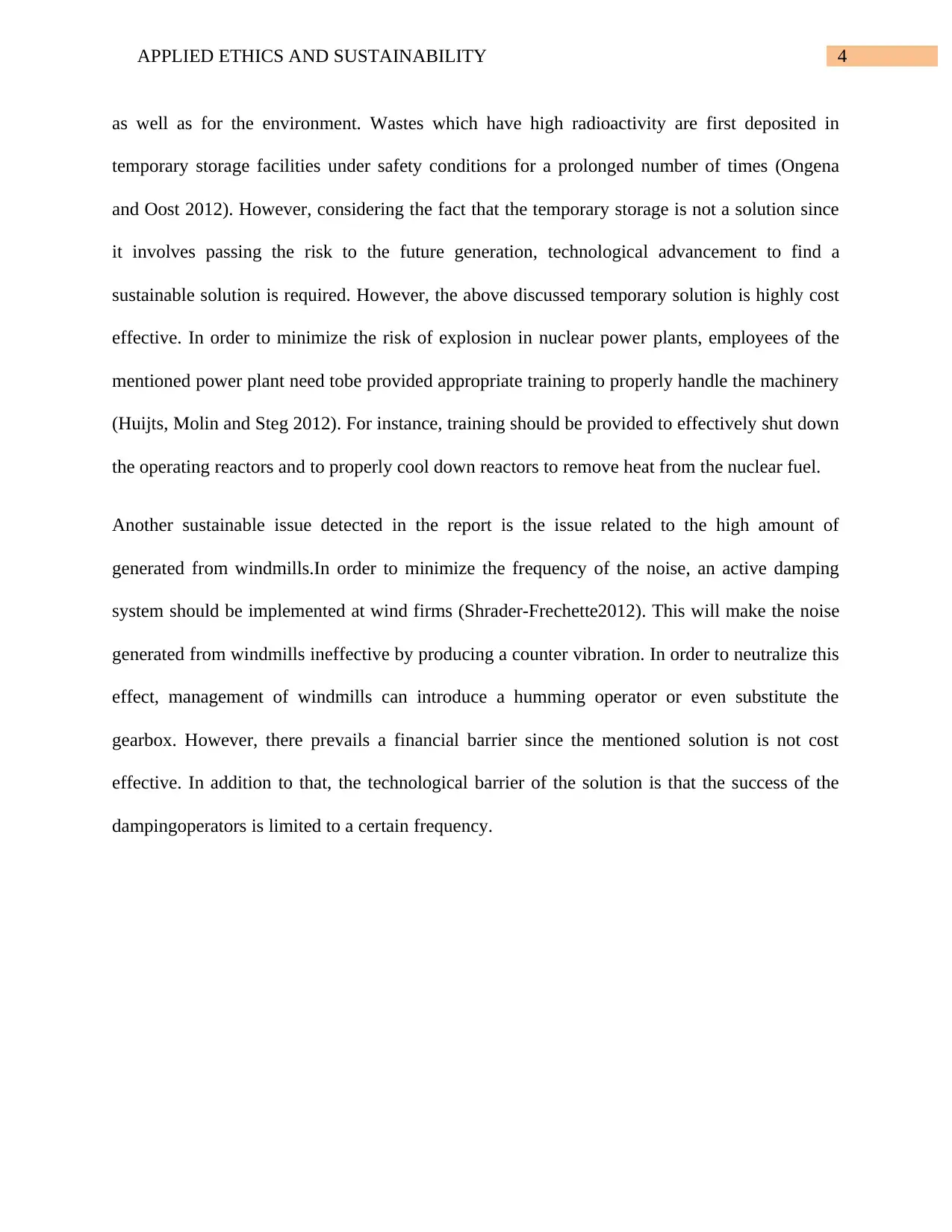
4APPLIED ETHICS AND SUSTAINABILITY
as well as for the environment. Wastes which have high radioactivity are first deposited in
temporary storage facilities under safety conditions for a prolonged number of times (Ongena
and Oost 2012). However, considering the fact that the temporary storage is not a solution since
it involves passing the risk to the future generation, technological advancement to find a
sustainable solution is required. However, the above discussed temporary solution is highly cost
effective. In order to minimize the risk of explosion in nuclear power plants, employees of the
mentioned power plant need tobe provided appropriate training to properly handle the machinery
(Huijts, Molin and Steg 2012). For instance, training should be provided to effectively shut down
the operating reactors and to properly cool down reactors to remove heat from the nuclear fuel.
Another sustainable issue detected in the report is the issue related to the high amount of
generated from windmills.In order to minimize the frequency of the noise, an active damping
system should be implemented at wind firms (Shrader-Frechette2012). This will make the noise
generated from windmills ineffective by producing a counter vibration. In order to neutralize this
effect, management of windmills can introduce a humming operator or even substitute the
gearbox. However, there prevails a financial barrier since the mentioned solution is not cost
effective. In addition to that, the technological barrier of the solution is that the success of the
dampingoperators is limited to a certain frequency.
as well as for the environment. Wastes which have high radioactivity are first deposited in
temporary storage facilities under safety conditions for a prolonged number of times (Ongena
and Oost 2012). However, considering the fact that the temporary storage is not a solution since
it involves passing the risk to the future generation, technological advancement to find a
sustainable solution is required. However, the above discussed temporary solution is highly cost
effective. In order to minimize the risk of explosion in nuclear power plants, employees of the
mentioned power plant need tobe provided appropriate training to properly handle the machinery
(Huijts, Molin and Steg 2012). For instance, training should be provided to effectively shut down
the operating reactors and to properly cool down reactors to remove heat from the nuclear fuel.
Another sustainable issue detected in the report is the issue related to the high amount of
generated from windmills.In order to minimize the frequency of the noise, an active damping
system should be implemented at wind firms (Shrader-Frechette2012). This will make the noise
generated from windmills ineffective by producing a counter vibration. In order to neutralize this
effect, management of windmills can introduce a humming operator or even substitute the
gearbox. However, there prevails a financial barrier since the mentioned solution is not cost
effective. In addition to that, the technological barrier of the solution is that the success of the
dampingoperators is limited to a certain frequency.
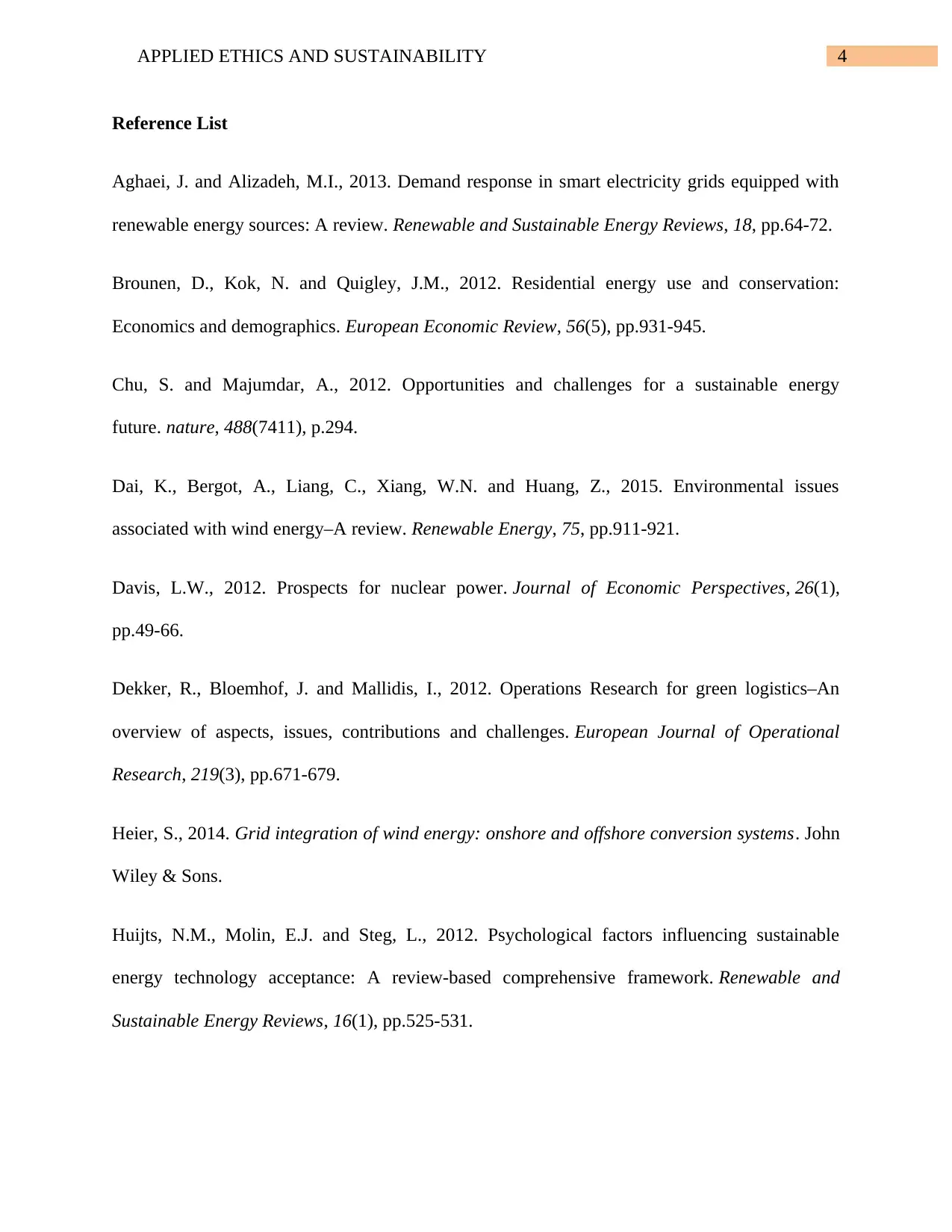
4APPLIED ETHICS AND SUSTAINABILITY
Reference List
Aghaei, J. and Alizadeh, M.I., 2013. Demand response in smart electricity grids equipped with
renewable energy sources: A review. Renewable and Sustainable Energy Reviews, 18, pp.64-72.
Brounen, D., Kok, N. and Quigley, J.M., 2012. Residential energy use and conservation:
Economics and demographics. European Economic Review, 56(5), pp.931-945.
Chu, S. and Majumdar, A., 2012. Opportunities and challenges for a sustainable energy
future. nature, 488(7411), p.294.
Dai, K., Bergot, A., Liang, C., Xiang, W.N. and Huang, Z., 2015. Environmental issues
associated with wind energy–A review. Renewable Energy, 75, pp.911-921.
Davis, L.W., 2012. Prospects for nuclear power. Journal of Economic Perspectives, 26(1),
pp.49-66.
Dekker, R., Bloemhof, J. and Mallidis, I., 2012. Operations Research for green logistics–An
overview of aspects, issues, contributions and challenges. European Journal of Operational
Research, 219(3), pp.671-679.
Heier, S., 2014. Grid integration of wind energy: onshore and offshore conversion systems. John
Wiley & Sons.
Huijts, N.M., Molin, E.J. and Steg, L., 2012. Psychological factors influencing sustainable
energy technology acceptance: A review-based comprehensive framework. Renewable and
Sustainable Energy Reviews, 16(1), pp.525-531.
Reference List
Aghaei, J. and Alizadeh, M.I., 2013. Demand response in smart electricity grids equipped with
renewable energy sources: A review. Renewable and Sustainable Energy Reviews, 18, pp.64-72.
Brounen, D., Kok, N. and Quigley, J.M., 2012. Residential energy use and conservation:
Economics and demographics. European Economic Review, 56(5), pp.931-945.
Chu, S. and Majumdar, A., 2012. Opportunities and challenges for a sustainable energy
future. nature, 488(7411), p.294.
Dai, K., Bergot, A., Liang, C., Xiang, W.N. and Huang, Z., 2015. Environmental issues
associated with wind energy–A review. Renewable Energy, 75, pp.911-921.
Davis, L.W., 2012. Prospects for nuclear power. Journal of Economic Perspectives, 26(1),
pp.49-66.
Dekker, R., Bloemhof, J. and Mallidis, I., 2012. Operations Research for green logistics–An
overview of aspects, issues, contributions and challenges. European Journal of Operational
Research, 219(3), pp.671-679.
Heier, S., 2014. Grid integration of wind energy: onshore and offshore conversion systems. John
Wiley & Sons.
Huijts, N.M., Molin, E.J. and Steg, L., 2012. Psychological factors influencing sustainable
energy technology acceptance: A review-based comprehensive framework. Renewable and
Sustainable Energy Reviews, 16(1), pp.525-531.
⊘ This is a preview!⊘
Do you want full access?
Subscribe today to unlock all pages.

Trusted by 1+ million students worldwide
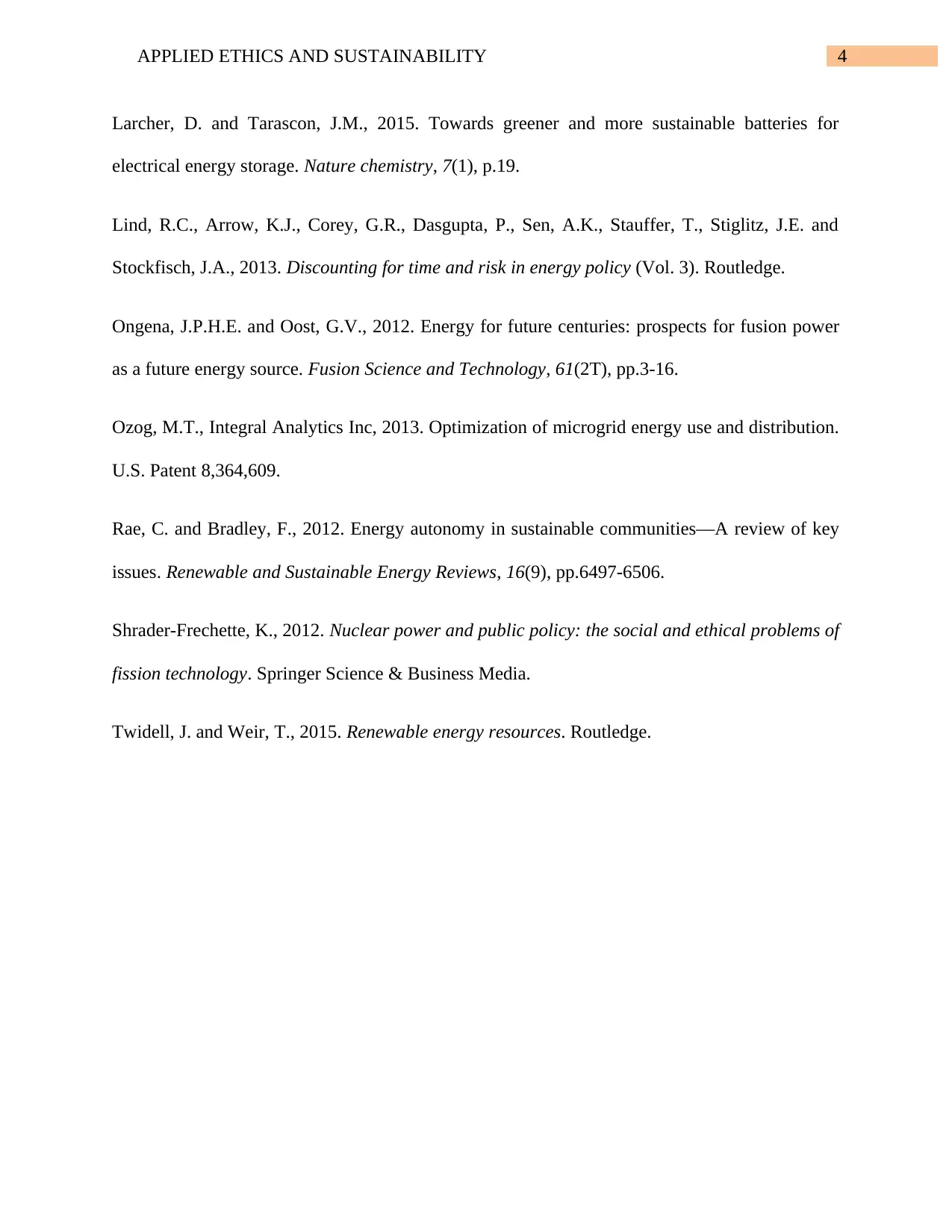
4APPLIED ETHICS AND SUSTAINABILITY
Larcher, D. and Tarascon, J.M., 2015. Towards greener and more sustainable batteries for
electrical energy storage. Nature chemistry, 7(1), p.19.
Lind, R.C., Arrow, K.J., Corey, G.R., Dasgupta, P., Sen, A.K., Stauffer, T., Stiglitz, J.E. and
Stockfisch, J.A., 2013. Discounting for time and risk in energy policy (Vol. 3). Routledge.
Ongena, J.P.H.E. and Oost, G.V., 2012. Energy for future centuries: prospects for fusion power
as a future energy source. Fusion Science and Technology, 61(2T), pp.3-16.
Ozog, M.T., Integral Analytics Inc, 2013. Optimization of microgrid energy use and distribution.
U.S. Patent 8,364,609.
Rae, C. and Bradley, F., 2012. Energy autonomy in sustainable communities—A review of key
issues. Renewable and Sustainable Energy Reviews, 16(9), pp.6497-6506.
Shrader-Frechette, K., 2012. Nuclear power and public policy: the social and ethical problems of
fission technology. Springer Science & Business Media.
Twidell, J. and Weir, T., 2015. Renewable energy resources. Routledge.
Larcher, D. and Tarascon, J.M., 2015. Towards greener and more sustainable batteries for
electrical energy storage. Nature chemistry, 7(1), p.19.
Lind, R.C., Arrow, K.J., Corey, G.R., Dasgupta, P., Sen, A.K., Stauffer, T., Stiglitz, J.E. and
Stockfisch, J.A., 2013. Discounting for time and risk in energy policy (Vol. 3). Routledge.
Ongena, J.P.H.E. and Oost, G.V., 2012. Energy for future centuries: prospects for fusion power
as a future energy source. Fusion Science and Technology, 61(2T), pp.3-16.
Ozog, M.T., Integral Analytics Inc, 2013. Optimization of microgrid energy use and distribution.
U.S. Patent 8,364,609.
Rae, C. and Bradley, F., 2012. Energy autonomy in sustainable communities—A review of key
issues. Renewable and Sustainable Energy Reviews, 16(9), pp.6497-6506.
Shrader-Frechette, K., 2012. Nuclear power and public policy: the social and ethical problems of
fission technology. Springer Science & Business Media.
Twidell, J. and Weir, T., 2015. Renewable energy resources. Routledge.
1 out of 10
Related Documents
Your All-in-One AI-Powered Toolkit for Academic Success.
+13062052269
info@desklib.com
Available 24*7 on WhatsApp / Email
![[object Object]](/_next/static/media/star-bottom.7253800d.svg)
Unlock your academic potential
Copyright © 2020–2025 A2Z Services. All Rights Reserved. Developed and managed by ZUCOL.





